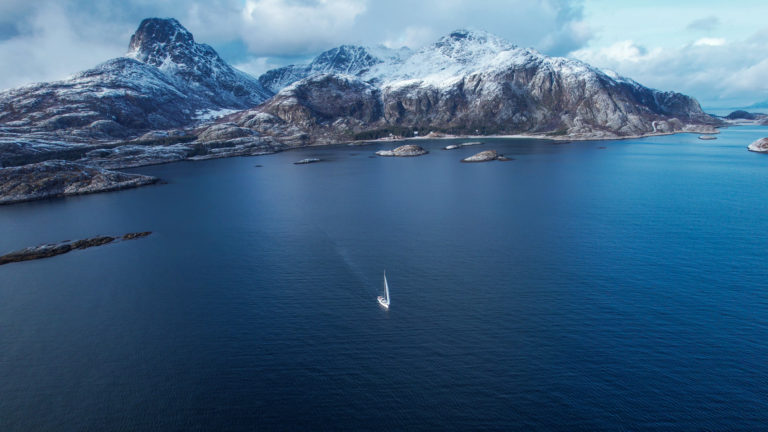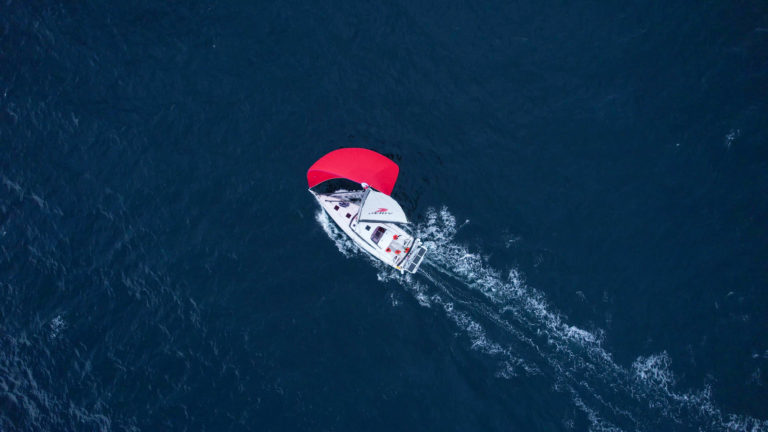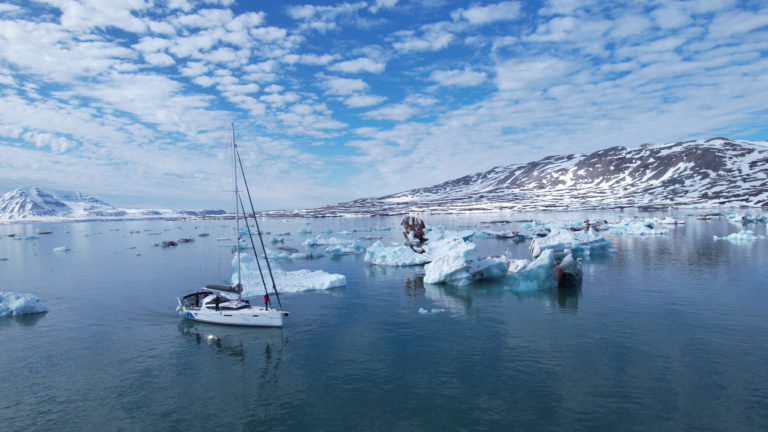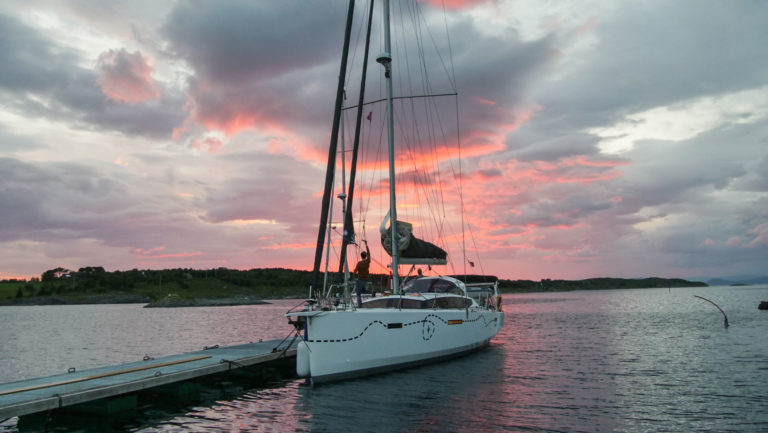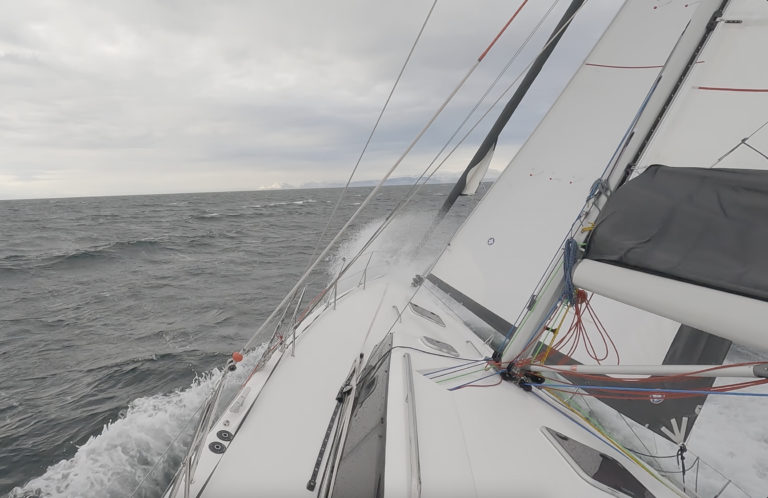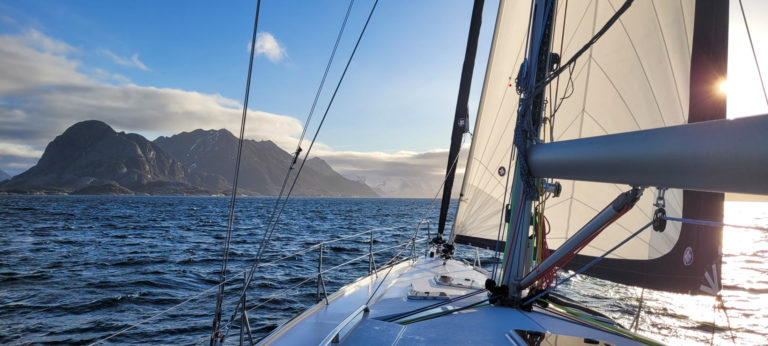JPK 45 FC
Le JPK 45 FC est un voilier de croisière performant, sûr et confortable. Pensé pour le grand voyage, il allie carène équilibrée, construction robuste et intérieur lumineux pour naviguer loin, longtemps et avec plaisir.
Un voilier pour voyager loin, avec confort et performance
Élu voilier de l’année dès sa sortie, le JPK 45 FC a pleinement rencontré son public de « grands voyageurs ». Concevoir le bateau de voyage idéal est un exercice subjectif … mais pour la plupart d’entre eux, les attentes sont finalement proches : un bateau robuste, avec une solidité proche de l’aluminium ; un bateau sécurisant par des performances et une stabilité élevées dans toutes les conditions ; enfin, sur le pont, une ergonomie favorisant une bonne protection de l’équipage, des postes de manœuvres sécurisés et un accastillage dimensionné de haute qualité.
The core of the JPK 45 FC :
- Une carène parfaitement équilibrée, pour des performances constantes et une stabilité en mer ;
- Une construction ultra robuste, pensée pour durer et affronter toutes les conditions : un véritable coffre-fort ;
- Une double version de quille (courte ou longue) selon le programme envisagé, avec dans les deux cas une stabilité équivalente ;
- Un aménagement intérieur moderne, lumineux et chaleureux, conçu pour offrir un véritable confort à bord, aussi bien dans les latitudes chaudes que sous des climats plus frais ;
- Des équipements fiables : moteur, accastillage, pompes, frigo, etc. sont choisis pour leur solidité et leur facilité d’entretien ;
- Enfin, une esthétique soignée, car « il ne coûte pas plus cher de faire joli » !
For those who are passionate about the sea, boats and travel, designing your ideal boat is an exciting exercise.
The JPK 45 is for me this perfect boat, the result of many years of cruising and ocean racing. Performant, seaworthy and solid, the JPK 45 is designed as a real "work boat" ... the work being the great cruising!Jean-Pierre Kelbert

Le JPK 45 « fast cruiser » : naviguer vite pour voyager loin
Le point de départ du projet : le dessin de la carène, naturellement confié à Jacques Valer, architecte historique du chantier. Qu’il s’agisse de voiliers de course ou de croisière, ses créations partagent un même ADN marin : des bateaux confortables en mer, stables, et parfaitement équilibrés.
En croisière, même si l’on privilégie les navigations portantes, il est indispensable de pouvoir remonter au vent de manière confortable et efficace. Une traversée de l’Atlantique dans le sens retour, par exemple, se déroule souvent « vent de face » : si le dessin de la carène est trop « open » ou si la construction ne permet pas un bon rapport de lest, la croisière peut rapidement virer au cauchemar.
Au portant comme au reaching, on attend du bateau qu’il reste équilibré, stable et planant. Il doit pouvoir maintenir des vitesses moyennes élevées sans trop solliciter le pilote ou le barreur, qui peut lui aussi se régaler en sensations.
Plan de pont : héritage de la course au large
Le JPK 45 FC peut être équipé au choix d’une capote standard ou d’une casquette rigide type dog house, pour un abri efficace en navigation. En version fermée, cette casquette forme un véritable poste de veille, protégé et confortable, permettant de naviguer sereinement quelles que soient les conditions météo. L’accès du cockpit à la plage avant est facilité et sécurisé grâce à une marche latérale et aux mains courantes disposées sur la casquette et le roof.
Conçu dans l’esprit de la course au large, le plan de pont offre une ergonomie de manœuvre particulièrement soignée.
- Les drisses de génois et trinquette reviennent sur des rails de tension au mat pour libérer les bloqueurs du piano et éviter l’usure sur les retours des poulies.
- Les drisses de spi et de gennaker reviennent au mat sur le winch dédié qui permet de gérer à la fois l’envoi et l’affalage.
- Les autres manœuvres essentielles – écoutes, ris, bordure, amure – sont renvoyées au cockpit sur les consoles de winches surélevées, situées en avant des doubles barres à roue. Cela libère complètement l’avant du cockpit pour plus de convivialité.
L’écoute de GV est fixée sur le dog house et n’entrave en rien la circulation dans le cockpit. C’est aussi un élément de sécurité, car il n’y a plus de risque de se faire faucher par l’écoute lors d’un empannage.
Les coffres d’assises renforcent le confort, avec sur babord un volume important pour le stockage de deux bouteilles de gaz de grand format, et sur tribord le radeau de survie qui est facilement accessible depuis la plage arrière pour des raisons de sécurité.
La longue delphinière permet l’amure de spis asymétriques ou de gennakers et accueille l’ancre. Derrière le guindeau, une baille à mouillage généreuse avec main courante offre un volume important pour les pare-battages et aussières. À l’arrière, une grande soute de pont et une marche de mise à l’eau complètent l’équipement. En option, un portique composite peut recevoir l’annexe, des panneaux solaires, éolienne, radar et antennes. Le tout est pensé pour allier efficacité à la voile, sécurité et convivialité aux escales.
Un voilier conçu pour voyager loin.
Le 17e JPK 45 FC « Kahuna » quittant Bodø au nord de la Norvège, en revenant du Svalbard par 80°N.
© Kahuna Adventure

Un intérieur lumineux, moderne et pensé pour naviguer
À bord du JPK 45 FC, l’intérieur est pensé comme un véritable lieu de vie : lumineux, moderne et chaleureux, il conjugue confort à l’escale et fonctionnalité en mer. Le carré déporté, réhaussé sur les réservoirs (700 L d’eau, 300 L de GO), offre un espace dégagé et convivial, tandis que la cuisine en long, équipée d’un meuble central, permet de cuisiner efficacement même à la gîte. De nombreuses mains courantes et un plancher antidérapant renforcent la sécurité en navigation.
La face avant du roof, verticale et équipée d’un pare-soleil, permet une vision dégagée vers l’avant tout en limitant l’exposition directe au soleil. Le plan d’aménagement prévoit une grande table à carte avec un siège de veille confortable, un grand local WC/douche en pied de descente, et deux cabines arrière doubles dont une convertible en atelier.
À l’avant, deux versions d’aménagement sont possibles :
- en standard, une cabine propriétaire précédée d’un sas de transition avec deux bannettes superposées et de nombreux rangements ;
- en option, après la baille à mouillage, une soute à voile (spi et gennaker) suivie d’une grande cabine propriétaire avec salle de bain sur babord et rangements sur tribord.
Deux options de quille
En standard, la quille fixe à bulbe pèse 4 tonnes et donne 2,20 m de tiran d’eau. Le voile de quille en fonte GS avec semelle d’encastrement (idéal pour répartir la charge en cas de talonnage) pèse 2 tonnes, et le bulbe en plomb pèse également 2 tonnes.
En option, une quille courte de type sabot avec 1,90 m de tiran d’eau. Avec 1300 kg de fonte GS et 3 tonnes de plomb, elle pèse 300 kg de plus que la version standard avec un dessin de quille assez élaboré pour conserver un plan antidérive efficace au près. La stabilité du bateau est quasi identique à la version standard et bien supérieure si on fait le choix du mat carbone, dont le prix est équivalent à l’option quille relevable imaginée au départ.
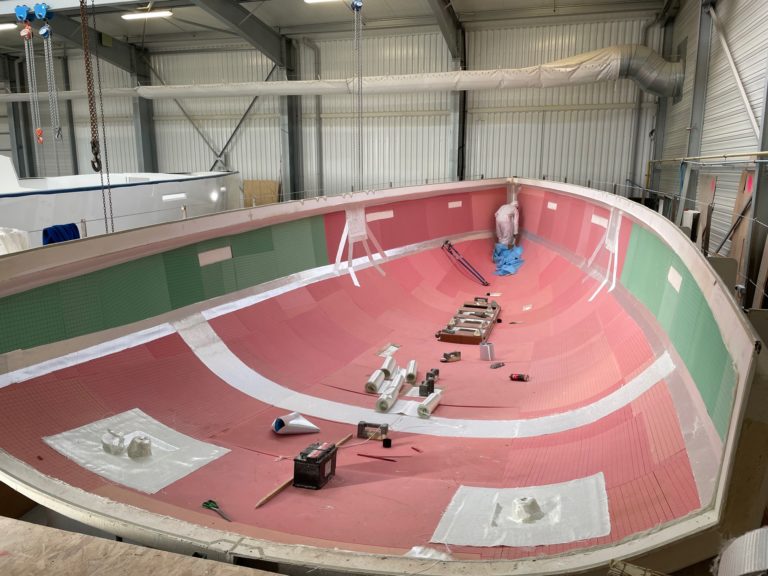

Une construction coffre-fort
Infused sandwich construction allows many possibilities. The choice of the number of layers and the type of fibre, the choice of the quality and density of the core of the sandwich... The infusion process makes it possible to laminate the entire hull and its structure under vacuum in a single operation, which guarantees total homogeneity. This technique produces a truly "safe" construction.
The JPK 45 is highly reinforced in the high stressed areas forward keel, hull bottom structure, mast and chainplate support, and keel base. The core of the sandwich in these areas is a high density foam with high impact absorption properties.
Weight savings are achieved in areas of low stress such as the topsides and some superstructures. The lower parts of the interior, as well as all the bulkheads, are also made of infused sandwich with an attachment to the hull and deck by lamination.
This meticulous construction results in an overall light hull that has nothing to do with the standard constructions of big shipyards, while being very resistant.
Détails techniques & documentation du JPK 45 FC
Retrouvez ci-dessous les informations clés sur le JPK 45 FC, la documentation technique et commerciale, et les articles de presse.
Dimensions
-
Longueur de coque 13,80 m
-
LWL 12,90 m
-
BOA 4,50 m
-
DraftVersion quille courte : 1,90 m
Version quille longue : 2,25 m
-
Displacement 11 t
-
Keel 4,1 t
-
Caburant 300 L
-
Eau douce 700 L
-
Mainsail 53 m²
-
Genoa 60 m²
-
Symetric spinnaker 125 m²
-
Asy spinnaker 205 m²

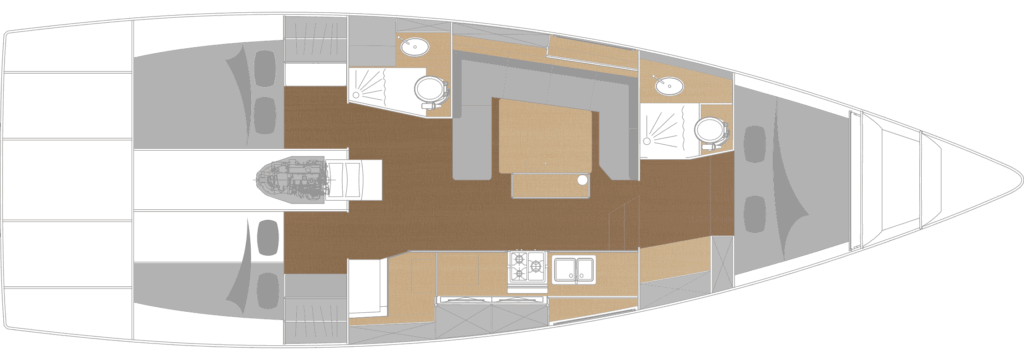
Documents
We're in the news


